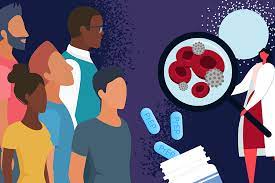Sustainability of Donor Funded HIV Prevention, Care, and Treatment Programs for Key Populations in Nigeria

Abstract:
Overseas development assistance (ODA) for HIV from bilateral
donors other then the US has fallen 57% in the last decade. HIV responses in low-
and middle-income countries is $8 billion short for 2025. Donors want national governments
to gradually take over HIV responses to maintain program gains and investments.
Programs with greater sustainability capacity can maintain positive outcomes and
benefits over time. We examine Nigeria's donor funded KP HIV program for sustainability.
A mixed-methods approach using
Washington University Program Sustainability Assessment Tool (PSAT) to survey perspectives
of key informants from HIV stakeholders. Overall and domain mean scores and standard
deviation determined, and quantitative analysis conducted using IBM Statistical Package for the Social Sciences
(SPSS) version 28. Thematic
analysis was applied to open-ended questions from key informant interviews. A total of 24 consenting respondents participated. Overall mean sustainability score was 4.72. Highest
mean scoring domains were program
adaptation (5.6) and program
evaluation (5.59), lowest means scores were partnerships (3.17) and
funding stability (3.56). Sociocultural
and political contexts hinder strategic behavioral change communication to promote
KP and quality services. Suboptimal political support, funding insecurity, limited
partnerships, and donor-driven strategic planning cycles threaten the program's
sustainability.
References:
[1] Joint
United Nations Programme on HIV/AIDS. in Danger: UNAIDS Global AIDS Update
2022. Geneva, Switzerland: Joint United Nations Programme on HIV/AIDS; 2022.
[2] Joint
United Nations Programme on HIV/AIDS. UNAIDS data 2022 [Internet]. Geneva,
Switzerland: Joint United Nations Programme on HIV/AIDS; 2022 [cited 2023 Mar
18]. Available from: https://www.unaids.org/en/resources/documents/2023/2022_unaids_data.
[3] Federal
Ministry of Health, Nigeria (2019). Nigeria HIV/AIDS Indicator and Impact
Survey (NAIIS) 2018: Technical Report. Abuja, Nigeria.
[4] Joint
United Nations Programme on HIV/AIDS Factsheet (2022). retrieved from: https://www.unaids.org/sites/default/files/media_asset/UNAIDS_FactSheet_en.pdf.
[5] Federal
Ministry of Health, Nigeria (2021). HIV/STI Integrated Biological &
Behavioural Surveillance Survey (IBBSS), 2021.
[6] Hunt
Jennifer, Bristowe Katherine, Chidyamatare Sybille, & Harding Richard.
(2017). They will be afraid to touch you’: LGBTI people and sex workers’
experiences of accessing healthcare in Zimbabwe—an in-depth qualitative study. BMJ Global Health.
[7] HIV
Prevention 2025 Roadmap. Getting on track to end AIDS as a Public Health threat
by 2030 Available and retrieved from https://hivpreventioncoalition.unaids.org/wp-content/uploads/2022/11/JC3053_2022-HIV-Road-Map-Publication_En_v6.pdf.
[8] PEPFAR Nigeria
SDS. (2022). Nigeria Country Operational Plan (COP) 2022 Strategic Direction
Summary.
[9] Schell,
S. F., Luke, D. A., Schooley, M. W., Elliott, M. B., Herbers, S. H., Mueller,
N. B., & Bunger, A. C. (2013). Public health program capacity for
sustainability: A new framework. Implementation Science, 8[1]. https://doi.org/10.1186/1748-5908-8-15.
[10] Huffstetler,
H. E., Bandara, S., Bharali, I., Kennedy Mcdade, K., Mao, W., Guo, F., Zhang,
J., Riviere, J., Becker, L., Mohamadi, M., Rice, R. L., King, Z., Farooqi, Z.
W., Zhang, X., Yamey, G., & Ogbuoji, O. (2022). The impacts of donor
transitions on health systems in middle-income countries: a scoping review.
Health Policy and Planning. https://doi.org/10.1093/heapol/czac063.
[11] Banigbe,
B., Audet, C. M., Okonkwo, P., Arije, O. O., Bassi, E., Clouse, K., Simmons,
M., Aliyu, M. H., Freedberg, K. A., & Ahonkhai, A. A. (2019). Effect of
PEPFAR funding policy change on HIV service delivery in a large HIV care and
treatment network in Nigeria. Plos One, 14(9). https://doi.org/10.1371/journal.pone.0221809.
[12] Flanagan,
K., Rees, H., Huffstetler, H., Mcdade, K. K., Yamey, G., Gonzalez, D., &
Hecht, R. (2018). Policy Impact in Global
Health.
[13] Lennox,
L., Maher, L., & Reed, J. (2018). Navigating the sustainability landscape:
A systematic review of sustainability approaches in healthcare. In
Implementation Science (Vol. 13, Issue 1). BioMed
Central Ltd. https://doi.org/10.1186/s13012-017-0707-4.
[14] Luke, D.
A., Calhoun, A., Robichaux, C. B., Moreland-Russell, S., & Elliott, M. B.
(2014). The program sustainability assessment tool: A new instrument for public
health programs. Preventing Chronic Disease, 11(2014). https://doi.org/10.5888/pcd11.130184.
[15] Calhoun,
A., Mainor, A., Moreland-Russel, S., Maier, R. C., Brossart, L., & Douglas,
L. A. (2014). Using the Program Sustainability Assessment Tool to Assess and
Plan for Sustainability.
[16] QSR
International. (2023). QDA Miner 6 [Computer software]. Available from https://www.qsrinternational.com/qda-miner-qualitative-data-analysis-software.
[17] Oberth,
G., & Whiteside, A. (2016). What does sustainability mean in the HIV and
AIDS response? African Journal of AIDS
Research, 15[1], 35–43. https://doi.org/10.2989/16085906.2016.1138976.
[18] Calhoun,
A., Mainor, A., Moreland-Russel, S., Maier, R. C., Brossart, L., & Douglas,
L. A. (2014). Using the Program Sustainability Assessment Tool to Assess and
Plan for Sustainability.
[19] Marum,
E., Conkling, M., Kanyanda, J., Gandi, S. B., Byaruhanga, R., & Alwano, M.
G. (2016). HIV Testing Services in Africa: Are They Sustainable? In Current HIV/AIDS
Reports (Vol. 13, Issue 5, pp. 263–268). Current
Medicine Group LLC 1. https://doi.org/10.1007/s11904-016-0328-6.
[20] Okere, N.
E., Lennox, L., Urlings, L., Ford, N., Naniche, D., Rinke De Wit, T. F.,
Hermans, S., Gomez, G.B., & Acquir, J. (2021). Exploring Sustainability in
the Era of Differentiated HIV Service Delivery in Sub-Saharan Africa: A
Systematic Review. http://links.lww.com/QAI/B644.
[21] Vu, M.,
Holec, M., Levine, R., Makunike-Chikwinya, B., Mukamba, J., Barnhart, S.,
Wiktor, S., Weiner, B., & Feldacker, C. (2022). Working toward
sustainability: Transitioning HIV programs from a USA-based organization to a
local partner in Zimbabwe. Plos one, 17(11
November).
[22] Joint
United Nations Programme on HIV/AIDS. Way forward to achieving sustainable AIDS
results [Internet]. Geneva, Switzerland: Joint United Nations Programme on
HIV/AIDS; 2018 Nov [cited 2023 Apr 14]. Available from: https://www.unaids.org/sites/default/files/media_asset/20181122_UNAIDS_PCB43_Way_fw_achieving_sustainable_AIDS_resp_results_EN.pdf.
[23] Research
Directorate, Immigration and Refugee Board, Canada. The Situation of Sexual and
Gender Minorities in Nigeria (2014-2018) [Internet]. Immigration and Refugee
Board Canada. 2019 [cited 2023 Apr 14]. Available from: https://irb.gc.ca/en/country-information/research/Pages/situation-gender-minorities-nigeria.aspx.
[24] United Nations General Assembly. Political Declaration on HIV and AIDS: Ending Inequalities and Getting on Track to End AIDS by 2030 [Internet]. Geneva, Switzerland: United Nations; 2021 Jun [cited 2023 Apr 14]. Available from: https://www.unaids.org/sites/default/files/media_asset/2021_political-declaration-on-hiv-and-aids_en.pdf.
[25] Iyamu I
(2020). The Findings of the National HIV / AIDS Indicator and Impact Survey (NAIIS)
Presents an Opportunity for a Pivot in the HIV / AIDS Response in Nigeria. Glob Health Annu Rev. 1[5]:22–4.

